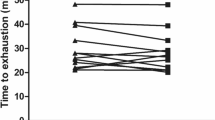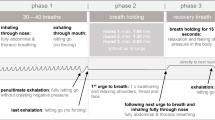Abstract
In endotherms, such as mammals and birds, internal organs can specialise to function within a narrow thermal range. Consequently, these organs should become more sensitive to changes in body temperature. Yet, organs at the periphery of the body still experience considerable fluctuations in temperature, which could select for lower thermal sensitivity. We hypothesised that the performance of soleus muscle taken from the leg would depend less on temperature than would the performance of diaphragm muscle taken from the body core. Soleus and diaphragm muscles were isolated from mice and subjected to isometric and work-loop studies to analyse mechanical performance at temperatures between 15 and 40 °C. Across this thermal range, soleus muscle took longer to generate isometric force and longer to relax, and tended to produce greater normalised maximal force (stress) than did diaphragm muscle. The time required to produce half of maximal force during isometric tetanus and the time required to relax half of maximal force were both more sensitive to temperature in soleus than they were in diaphragm. However, thermal sensitivities of maximal force during isometric tetani were similar for both muscles. Consistent with our hypothesis, power output (the product of speed and force) was greater in magnitude and more thermally sensitive in diaphragm than it was in soleus. Our findings, when combined with previous observations of muscles from regionally endothermic fish, suggest that endothermy influences the thermal sensitivities of power output in core and peripheral muscles.





Similar content being viewed by others
References
Altringham JD, Block BA (1997) Why do tuna maintain elevated slow muscle temperatures? Power output of muscle isolated from endothermic and ectothermic fish. J Exp Biol 200:2617–2627
Altringham JD, Young IA (1991) Power output and the frequency of oscillatory work in mammalian diaphragm muscle: the effects of animal size. J Exp Biol 157:318–389
Angilletta MJ Jr (2009) Thermal adaptation. A theoretical and empirical synthesis. Oxford University Press, Oxford
Angilletta MJ Jr, Cooper BS, Schuler MS, Boyles JG (2010) The evolution of thermal physiology in endotherms. Front Biosci E2:861–881
Bennett AF (1984) Thermal dependence of muscle function. Am J Physiol 247:R217–R229
Bernal D, Smith D, Lopez G, Weitz D, Grimminger T, Dickson K, Graham JB (2003) Comparative studies of high performance swimming in sharks II. Metabolic biochemistry of locomotor and myocardial muscle in endothermic and ectothermic sharks. J Exp Biol 206:2845–2857
Bernal D, Donley JM, Shadwick RE, Syme DA (2005) Mammal-like muscles power swimming in a cold-water shark. Nature 437:1349–1352
Caiozzo VJ (2002) Plasticity of skeletal muscle phenotype: mechanical consequences. Muscle Nerve 26:740–768
Castle PC, Macdonald AL, Philp A, Webborn A, Watt PW, Maxwell NS (2006) Precooling leg muscle improves intermittent sprint exercise performance in hot, humid conditions. J Appl Physiol 100:1377–1384
Choi IH, Cho Y, Oh YK, Jung NP, Shin HC (1998) Behavior and muscle performance in heterothermic bats. Physiol Zool 71:257–266
Crawley MJ (2007) The R book. Wiley, New York
Curtin NA, Woledge RC (1993a) Efficiency of energy conversion during sinusoidal movement of white muscle fibres from the dogfish Scyliorhinus canicula. J Exp Biol 183:137–147
Curtin NA, Woledge RC (1993b) Efficiency of energy conversion during sinusoidal movement of red muscle fibres from the dogfish Scyliorhinus canicula. J Exp Biol 185:195–206
De Ruiter CJ, Jones DA, Sargeant AJ, De Haan A (1999) Temperature effect on the rates of isometric force development and relaxation in the fresh and fatigued human adductor pollicis muscle. Exp Physiol 84:1137–1150
Donley JM, Shadwick RE, Sepulveda CA, Syme DA (2007) Thermal dependence of contractile properties of the aerobic locomotor muscle in the leopard shark and shortfin mako shark. J Exp Biol 210:1194–1203
Donley JM, Sepulveda CA, Aalbers SA, McGillivray DG, Syme DA, Bernal D (2012) Effects of temperature on power output and contraction kinetics in the locomotor muscle of the regionally endothermic common thresher shark (Alopias vulpinus). Fish Physiol Biochem 38:1507–1519
Ducharme MB, VanHelder WP, Radomski MW (1991) Tissue temperature profile in the human forearm during thermal stress at thermal stability. J Appl Physiol 71:1973–1978
Herrel A, James RS, Van Damme R (2007) Fight versus flight: physiological basis for temperature dependent behavioral shifts in lizards. J Exp Biol 210:1762–1767
James RS (2013) A review of the thermal sensitivity of the mechanics of vertebrate skeletal muscle. J Comp Physiol 183:723–733
James RS, Altringham JD, Goldspink DF (1995) The mechanical properties of fast and slow skeletal muscles of the mouse in relation to their locomotory function. J Exp Biol 198:491–502
James RS, Young IS, Cox VM, Goldspink DF, Altringham JD (1996) Isometric and isotonic muscle properties as determinants of work loop power output. Pflug Arch Eur J Physiol 432:767–774
James RS, Tallis J, Herrel A, Bonneaud C (2012) Warmer is better: thermal sensitivity of both maximal and sustained power output in the iliotibialis muscle isolated from adult Xenopus tropicalis. J Exp Biol 215:552–558
Josephson RK (1985) Mechanical power output from striated muscle during cyclic contraction. J Exp Biol 114:493–512
Kenny GP, Reardon FD, Zaleski W, Reardon ML, Haman F, Ducharme MB (2003) Muscle temperature transients before, during, and after exercise measured using an intramuscular multisensor probe. J Appl Physiol 94:2350–2357
Lovegrove BG, Heldmaier G, Ruf T (1991) Perspectives of endothermy revisited: the endothermic temperature range. J Therm Biol 16:185–197
Marsh RL (1994) Jumping ability of anurans. In: Jones JH (ed) Comparative vertebrate exercise physiology. Academic Press, San Diego, pp 51–111
Méndez J, Keys A (1960) Density and composition of mammalian muscle. Metabolism 9:184–188
Pinheiro J, Bates D, DebRoy S, Sarkar D, the R Development Core Team (2011) nlme: linear and nonlinear mixed effects models. R PackageVersion 3.1-102
Rall JA, Woledge RC (1990) Influence of temperature on mechanics and energetics of muscle contraction. Am J Physiol 259:R197–R203
Ranatunga KW (1982) Temperature-dependence of shortening velocity and rate of isometric tension development in rat skeletal muscle. J Physiol 329:465–483
Ranatunga KW (1998) Temperature dependence of mechanical power output in mammalian (rat) skeletal muscle. Exp Physiol 83:371–376
Refinetti R (1999) Amplitude of the daily rhythm of body temperature in eleven mammalian species. J Therm Biol 2:477–481
Rome LC, Swank D (1992) The influence of temperature on power output of scup red muscle during cyclical length changes. J Exp Biol 171:261–281
Saltin B, Gagge AP, Stolwijk JA (1968) Muscle temperature during submaximal exercise in man. J Appl Physiol 25:679–688
Seebacher F, James RS (2008) Plasticity of muscle function in a thermoregulating ectotherm (Crocodylus porosus): biomechanics and metabolism. Am J Physiol 294:R1024–R1032
Seebacher F, Tallis JA, James RS (2014) The cost of muscle power production: muscle oxygen consumption per unit work increases at low temperatures in Xenopus laevis Daudin. J Exp Biol 217:1940–1945
Steury TD, Murray DL (2005) Regression versus ANOVA. Front Ecol Environ 3:356–357
Swoap SJ, Johnson TP, Josephson RK, Bennett AF (1993) Temperature, muscle power output, and limitations on burst locomotor performance of the lizard Dipsosaurus dorsalis. J Exp Biol 174:185–197
Syme DA (2006) Functional properties of skeletal muscle. In: Shadwick RE, Lauder GV (eds) Randall DJ, Farrell AP (series eds) Fish physiology: fish biomechanics, vol 23. Academic Press, Waltham, pp 179–240
Therneau T, Lumley T (2009) Survival: survival analysis, including penalised likelihood. R package version 2.35-8. http://www.CRAN.R-project.org/package=survival
Wood SN (2004) Stable and efficient multiple smoothing parameter estimation for generalized additive models. J Am Stat Assoc 99:673–686
Wooden KM, Walsberg GE (2004) Body temperature and locomotor capacity in a heterothermic rodent. J Exp Biol 207:41–46
Yaicharoen P, Wallman K, Morton A, Bishop D (2012) The effect of warm-up on intermittent sprint performance and selected thermoregulatory parameters. J Sci Med Sport 15:451–456
Zuur AF, Leno EN, Walker N, Saveliev AA, Smith GM (2009) Mixed effects models and extensions in ecology with R. Springer, New York
Acknowledgments
Thanks to Mark Bodycote, Bethan Grist and Roy Petticrew for technical assistance. This research was supported by Coventry University, UK. Many thanks to the referees for their constructive comments.
Author information
Authors and Affiliations
Corresponding author
Additional information
Communicated by I. D. Hume.
Rights and permissions
About this article
Cite this article
James, R.S., Tallis, J. & Angilletta, M.J. Regional thermal specialisation in a mammal: temperature affects power output of core muscle more than that of peripheral muscle in adult mice (Mus musculus). J Comp Physiol B 185, 135–142 (2015). https://doi.org/10.1007/s00360-014-0872-6
Received:
Accepted:
Published:
Issue Date:
DOI: https://doi.org/10.1007/s00360-014-0872-6




